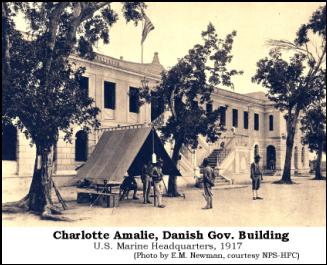Acquisition of the Danish West Indies by the United States
March 31, 2005, marks the 88th anniversary of the acquisition of the Danish West Indies by the United States of America. It also marks the 140th anniversary of when this acquisition was first contemplated… It was in 1865, some fifty-plus years prior, the United States began discussions regarding this purchase.

In 1865, it was the Confederacy’s use of the Danish West Indies as a coaling station during the War Between the States that first prompted President Abraham Lincoln and Secretary of State William Seward to seek a port in the West Indies for strategic reasons. Moreover, the United States did not want these islands to fall into the hands of any other power. In this year, the Danish Foreign Minister was approached at a dinner party to see if the Danish West Indies were for sale.
In 1867, Denmark offered to sell St. John and St. Thomas for $10 million with an option on St. Croix for $5 million. Settlement was reached for $7.5 million for the two islands, a favorable vote was taken in the territory, as well as both houses of the Danish parliament, but the US Senate declined to act. Largely, it is thought that the refusal of the Senate to ratify the treaty was based on the absence of full support for the necessity of this acquisition to safeguard American security, and to advance commercial interests.
From the early 1870s, rumors circulated that Denmark was preparing to sell the islands to Germany. While these rumors were thought to be false, it was of great concern to our State Department. The rumors persisted for the next several decades and intermittent interest was shown by the United States for these islands. In the late 1800s negotiations once again began and this time the Senate approved the terms for the sale, but it was ultimately rejected in 1902 by Denmark.
While a general interest continued to be expressed, it was not until 1915 that the United States once again initiated serious discussions about the acquisition of the islands. This time, it was clearly the concern over the potential of Denmark coming under control of Germany, or of Germany requiring Denmark to cede control of the islands, which made the U.S. take action. Further, an increasing concern to the United States was the fact that the Panama Canal had recently opened, and the Danish West Indies was considered a strategic location in the defense of the Canal, should this become necessary. The US made it clear to Denmark that it would never allow the islands to be annexed by Germany.

Negotiations were successfully completed and the Treaty of cession was signed on August 4, 1916. On December 22, 1916 the Treaty received the signature of the King of Denmark, and January 16, 1917 President Wilson signed it. The United States paid $25 million. In return, the US received the three main islands, the adjacent islands and rocks and all property rights in public, government and Crown lands. Danish citizens retained all property rights and could decide whether they wished to remain or leave. However, they were not granted US citizenship. This issue would not be resolved until 1927, when a congressional enactment granted U.S. Citizenship to several categories of Virgin Islanders, and in 1932, when a further Act filled the gaps left by the 1927 Act. The U.S. agreed to recognize Denmark’s right to the whole of Greenland as part of the negotiations.
On March 3, 1917, the U.S. Congress, made provisions for the VI government. It was decided that the Colonial form of government introduced into the territory by Denmark though the Colonial Law of 1906 should remain, including the two Colonial-municipal councils. Executive power was vested in the President of the US, but he could delegate his power to a governor and such person or persons as he may appoint. Because of the VI’s unincorporated territory status, and its military importance, officers of the United States Navy were designated to run the government.
This form of government was intended to be a temporary measure, until the next session of Congress could put in place a permanent set of procedures. Due to a number of factors, and even though a number of attempts were made to adopt a Constitution (Organic Act), Naval rule continued until 1931. The Organic Act was not adopted until 1936.

Formal transfer ceremonies were held in St. Thomas and St. Croix on March 31, 1917. The ceremony on St. Thomas was most impressive, though Governor Oliver, appointed by President Wilson, could not arrive in time to take part in it. Commander Pollock, of the gunboat Hancock, was at Santo Domingo and was ordered to proceed at once to St. Thomas and take possession in the name of the United States.
Formal ceremonies on St. John did not occur until April 15, 1917, when the new Governor arrived by U.S. ship Dolphin, and Carl Francis, along with Policeman Moorehead, raised the National flag over Christiansfort (the Cruz Bay Battery) for the first time.
More information can be ascertained from the following: The Transition from Danish Colony to American Territory, 1867-1917, by Helen M. King; The Virgin Islands from Navy Base to New Deal, Luther Evans; A History of the Virgin Islands, Isaac Dookkan; and St. John Backtime, Ruth Low and Rafael Valls.
[Transfer]
